A 246 million-year-old reptile fossil found in New Zealand has been identified as the oldest marine reptile fossil in the Southern Hemisphere. The fossil is from a nothosaur, an extinct aquatic reptile that lived during the Triassic period. These reptiles invaded the seas about 252 million years ago after a catastrophic mass extinction. Nothosaurs were predecessors of Plesiosaurs and swam with four limbs, growing up to 23 feet in length. The discovery of the nothosaur fossil in New Zealand has shed new light on the previously unknown record of early sea reptiles in the Southern Hemisphere.
The nothosaur fossil was first excavated from a boulder at the foot of Mount Harper on the South Island of New Zealand in 1978 but was not fully recognized for its importance until recently. It took expertise from paleontologists from Sweden, Norway, New Zealand, Australia, and East Timor to analyze the fossil and associated fossils. The lead author of the study, Dr. Benjamin Kear, stated that the nothosaur fossil is more than 40 million years older than any previously discovered sauropterygian fossil in the Southern Hemisphere. This discovery has completely changed scientists’ understanding of how nothosaurs migrated globally from the equator to the poles.
The nothosaur fossil has provided valuable information about the environment in which these ancient sea reptiles lived. They thrived in shallow coastal environments filled with marine creatures within what was then the southern polar circle. The study has shown that these reptiles originated near the equator and then spread both northwards and southwards as complex marine ecosystems re-established following the mass extinction at the beginning of the Age of Dinosaurs. The extreme global warming during this period allowed the marine reptiles to thrive at the South Pole, hinting that the polar regions were a likely route for their earliest global migrations.
The discovery of the nothosaur fossil in New Zealand has also opened the possibility of finding more fossil remains of long-extinct sea reptiles in the Southern Hemisphere and other regions. The study of this ancient reptile has provided valuable insights into the evolutionary history and global distribution of sauropterygian reptiles. Through the use of time-calibrated evolutionary models, scientists have been able to reconstruct how these creatures migrated across the globe and adapted to changing environments. The discovery has added to the growing body of knowledge about prehistoric marine life and the impact of cataclysmic events on species adaptations and distribution.
Overall, the nothosaur fossil discovery in New Zealand has significantly contributed to the understanding of ancient marine reptiles and their migration patterns. The findings have not only shed light on the previously unknown record of these reptiles in the Southern Hemisphere but have also provided insights into the environmental conditions that allowed them to thrive globally. The study highlights the importance of collaboration among scientists from various countries to analyze and interpret valuable fossil discoveries. The ongoing research in paleontology continues to uncover new information about the evolution of life on Earth and the adaptations of species to changing environmental conditions.


